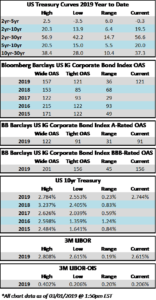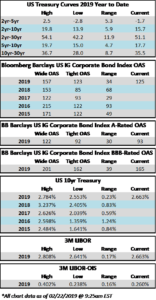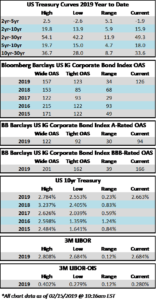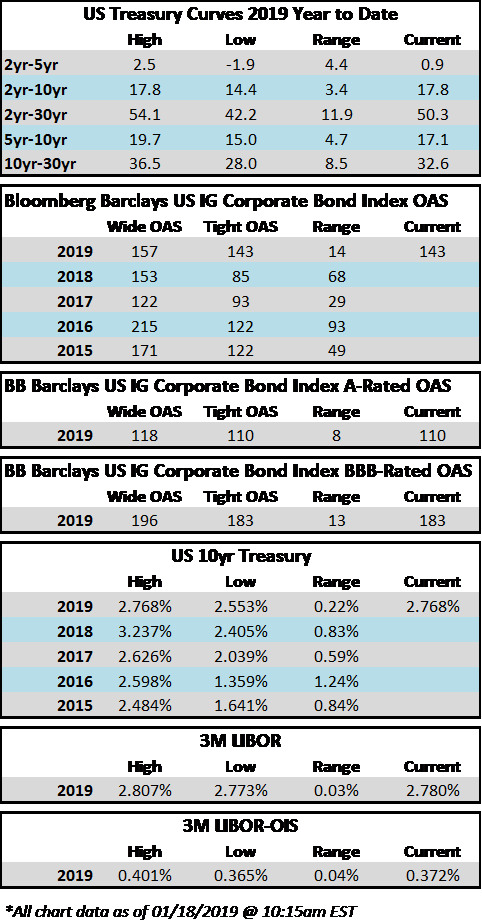Fund Flows & Issuance: According to a Wells Fargo report, flows week to date were -$1.2 billion and year to date flows stand at $9.7 billion. New issuance for the week was $5.0 billion and year to date HY is at $38.0 billion, which is -6% over the same period last year.
(Bloomberg) High Yield Market Highlights
- S. junk bond yields jumped the most in four weeks, closing at a two-week high, as returns turned negative across ratings for a third consecutive session, the worst run since January. Triple C bonds suffered the biggest decline since December.
- Yields rose in 5 of the last 9 trading sessions as S&P 500 dropped the most in 4 weeks to close at 3-week low
- Equity fell for 4 straight sessions for first time since December
- VIX rose for 4 straight sessions for the first time since October, closing at a 5-week high
- Nervous junk bond investors withdrew cash from high yield funds, the first negative flow since January
- Resilience of high yield was evident in steady pricing of new issues
- Biggest LBO deal YTD, Power Solutions, had $15b in orders for senior secured and unsecured tranche combined, after just two days of roadshow
- Junk bonds still remain best-performing in fixed income, with YTD return of 6.07%
- CCC bonds fell 0.18% yesterday, have gained 6.38% YTD
- High yield maintained lead over loans, which returned 4.16% YTD
- S. junk bonds operate against the backdrop of strong technicals as reflected in slow issuance, low default rate, steady corporate earnings
(Bloomberg) CenturyLink Finds ‘Material’ Accounting Issues With Level 3
- CenturyLink Inc. discovered a “material weakness” in accounting involving the value of assets acquired with the 2017 purchase of Level 3 Communications and notified regulators that its 10-K filing will be late.
- CenturyLink said it found problems with “internal controls” in its books involving recording and “measuring fair value of assets and liabilities” it took over with the Level 3
acquisition, according to a filing Monday. The rural telephone company said it needs to audit the accounting before it can report its year-end numbers, but that the problem won’t cause any material changes to the results it reported Feb. 13. - Monroe, Louisiana-based CenturyLink bought Level 3 to strengthen its sales to businesses and cope with a long-running decline in landline demand. The company — one of the largest junk-bond issuers in the U.S. — is part of a challenging industry that includes Windstream Holdings Inc., which filed for bankruptcy protection last month.
(Bloomberg) Digital Colony Is Said to Weigh Bid for Zayo
- Digital Colony, a communications infrastructure-focused firm formed by Tom Barrack’s Colony Capital Inc. and Digital Bridge Holdings LLC, is part of a potential buyer group weighing a bid for Zayo Group Holdings Inc., according to a person with knowledge of the matter.
- The group, led by Digital Colony and investment firm EQT, has fully committed debt financing, said the person, who asked not to be named because the matter is private. A Digital Colony representative didn’t immediately respond to a request for comment, and an EQT representative declined to comment.
- Zayo is a Boulder, Colorado-based owner of fiber networks across North America and Europe on Wednesday said it’s “evaluating strategic alternatives.”
- Zayo, led by Chief Executive Officer Dan Caruso, postponed its analyst day, and said it will take “a minimum of several weeks to months” to consider its options, though there’s no set timetable nor assurance a strategic alternative will result.
(Bloomberg) T-Mobile’s Sprint Deal Draws State Concerns Over Consumer Harm
- State antitrust enforcers are expressing deep concerns that T-Mobile US Inc.’s proposed takeover of Sprint Corp. could raise prices for consumers, signaling they might seek to thwart the deal.
- Some state attorneys general who are investigating the $26 billion transaction took the unusual step this week of publicly voicing worries that the combination could harm competition, offering insight for the first time into how they view the tie- up.
- Maryland Attorney General Brian Frosh, a Democrat, said combining T-Mobile and Sprint would further concentrate an already consolidated industry by leaving just three national carriers. “That’s dangerous for competition. That’s dangerous for consumers,” Frosh said in an interview on the sidelines of an annual conference in Washington for state attorneys general.
- The comments come after more than a dozen states joined to investigate the deal in parallel with the Justice Department and the Federal Communications Commission, which are nearing the end of their reviews.
- The tie-up has been widely criticized by consumer groups and Democratic lawmakers who want officials to oppose the deal. The states can sue to block the merger on antitrust grounds even if federal officials approve the takeover.



